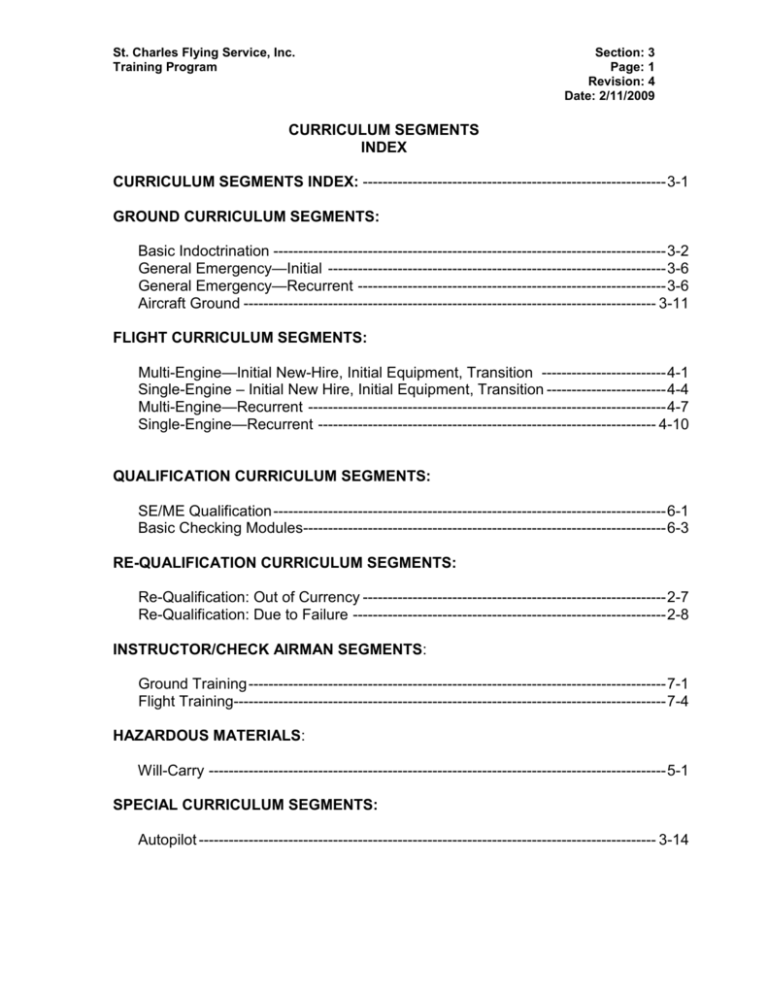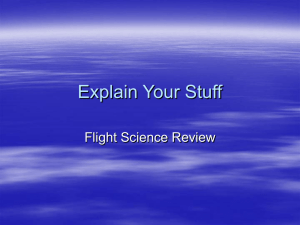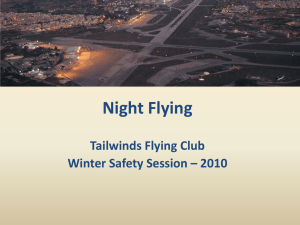curriculum segment - St. Charles Flying Service
advertisement

St. Charles Flying Service, Inc. Training Program Section: 3 Page: 1 Revision: 4 Date: 2/11/2009 CURRICULUM SEGMENTS INDEX CURRICULUM SEGMENTS INDEX: ------------------------------------------------------------- 3-1 GROUND CURRICULUM SEGMENTS: Basic Indoctrination ------------------------------------------------------------------------------- 3-2 General Emergency—Initial -------------------------------------------------------------------- 3-6 General Emergency—Recurrent -------------------------------------------------------------- 3-6 Aircraft Ground ----------------------------------------------------------------------------------- 3-11 FLIGHT CURRICULUM SEGMENTS: Multi-Engine—Initial New-Hire, Initial Equipment, Transition ------------------------- 4-1 Single-Engine – Initial New Hire, Initial Equipment, Transition ------------------------ 4-4 Multi-Engine—Recurrent ------------------------------------------------------------------------ 4-7 Single-Engine—Recurrent -------------------------------------------------------------------- 4-10 QUALIFICATION CURRICULUM SEGMENTS: SE/ME Qualification ------------------------------------------------------------------------------- 6-1 Basic Checking Modules------------------------------------------------------------------------- 6-3 RE-QUALIFICATION CURRICULUM SEGMENTS: Re-Qualification: Out of Currency ------------------------------------------------------------- 2-7 Re-Qualification: Due to Failure --------------------------------------------------------------- 2-8 INSTRUCTOR/CHECK AIRMAN SEGMENTS: Ground Training ------------------------------------------------------------------------------------ 7-1 Flight Training--------------------------------------------------------------------------------------- 7-4 HAZARDOUS MATERIALS: Will-Carry -------------------------------------------------------------------------------------------- 5-1 SPECIAL CURRICULUM SEGMENTS: Autopilot -------------------------------------------------------------------------------------------- 3-14 St. Charles Flying Service, Inc. Training Program CURRICULUM SEGMENT: OBJECTIVE: Section: 3 Page: 2 Revision: 4 Date: 2/11/2009 BASIC INDOCTRINATION To introduce the new-hire crewmember to the Company and its manner or conducting operations in air transportation, to acquaint the crewmember with the company’s policies, procedures, forms, organizational and administrative practices, and to ensure the crewmember has acquired basic airman knowledge. INSTRUCTIONAL DELIVERY METHODS: Lecture, CBT TRAINING AIDS: POH, Audio/Visuals COURSEWARE: Lesson Plan, GOM, FAR/AIM, POH, FAA Pub’s/ AC’s TESTING / CHECKING: Oral Examination OPERATOR SPECIFIC 1) DUTIES AND RESPONSIBILITIES a) b) c) d) e) f) g) h) Company history, organization, and management structure Operational concepts, policies, and kind of operation Company forms, records, and administrative procedures Employee standards and rules of conduct Employee compensation, benefits, and contracts Authority and responsibility of duty position Company required equipment Appropriate portions of company operating manual, organization revisions, and employee responsibilities concerning manuals 2) APPROPRIATE PROVISIONS OF THE FEDERAL AVIATION REGULATIONS a) Fight crewmember certification, training, and qualification requirements b) Medical certificates, physical examination, drug testing, and fitness for duty requirements c) Operational Control requirements (flight locating) St. Charles Flying Service, Inc. Training Program Section: 3 Page: 3 Revision: 4 Date: 2/11/2009 d) Flight duty and rest requirements e) Record keeping requirements f) Operational rules in parts 61, 91, and 135 and any other applicable regulations g) Regulatory requirements for company manual h) Other appropriate regulations such as flight crew emergency authority, interference with crewmembers, and reporting requirements 3) CONTENTS OF CERTIFICATE AND OPERATING SPECIFICATIONS a) b) c) d) e) Regulatory basis in Part 135 and Title 49, U.S.C. Definitions, descriptions, and organization of Operations specifications Limitations and authorizations of Operations Specifications Description of certificate Description of FAA Certificate Holding District Office and responsibilities of FAA principal inspectors AIRMAN SPECIFIC 1) COMPANY FLIGHT CONTROL a) b) c) d) Flight locating system and procedures Organizations, duties, and responsibilities Weather and NOTAM information Company communications 2) WEIGHT AND BALANCE a) b) c) d) Definitions General loading procedures and center of gravity computations Effects of fuel burn and load shifts in flight Weight and balance forms, load manifests, fuel slips, and other applicable documents. 3) AIRCRAFT PERFORMANCE AND AIRPORT ANALYSIS a) b) c) d) Definitions Effects of temperature and density altitude General TERP's criteria Airport analysis system as appropriate to the type of operation and family or families of aircraft e) Runway limitations for takeoff and landing including effects of contaminated runways St. Charles Flying Service, Inc. Training Program Section: 3 Page: 4 Revision: 4 Date: 2/11/2009 4) METEOROLOGY a) b) c) d) e) f) g) Basic weather definitions Temperature, pressure and winds Atmosphere, moisture, and clouds Air masses and fronts Thunderstorms, icing, and windshear Reduced visibility including fog Procedures for recognizing and avoiding severe weather 5) NAVIGATION a) b) c) d) e) Definitions Basic navigation instruments Dead reckoning and pilotage concepts and procedures Navigational aids VHF, GPS situational awareness 6) AIRSPACE AND ATC PROCEDURES a) b) c) d) e) f) g) Definitions Description of airspace Controllers and pilots responsibilities Navigational performance and separation standards ATC communications procedures (normal and emergency) Air traffic flow control ATC phraseology 7) EN ROUTE AND TERMINAL AREA CHARTING AND FLIGHT PLANNING a) b) c) d) e) f) Terminology of charting services Take off minimums, landing minimums, and alternate requirements General company flight planning procedures Flight service stations and international procedures Airport diagrams Airport Ground Operational Safety (AC 120-74 and AC 91-73) St. Charles Flying Service, Inc. Training Program Section: 3 Page: 5 Revision: 4 Date: 2/11/2009 8) CONCEPTS OF INSTRUMENT APPROACHES a) b) c) d) e) f) g) h) Definitions Holding patterns and procedure turns Precision approaches (per Company Ops Specs) Non precision approaches (per Company Ops Specs) Circle to land procedures and limitations Visual approaches, requirements and procedures Contact approaches, procedures and limitations Visual cues before and during descent below DH or MDA 9) EMPLOYEE ASSISTANCE PROGRAM a) The effects and consequences of drug use in personal health, safety and work environment b) The manifestation and behavioral cues that may indicate drug use and abuse c) Documentation of training to employees and employer’s supervisory personnel St. Charles Flying Service, Inc. Training Program CURRICULUM SEGMENT: OBJECTIVE: Section: 3 Page: 6 Revision: 4 Date: 2/11/2009 GENERAL EMERGENCY - INITIAL To develop the necessary knowledge and skills in the actual use of certain items of emergency equipment, as well as the procedures to be followed when emergency situations occur. INSTRUCTIONAL DELIVERY METHODS: Lecture, Demonstration & Drill. Emergency Equipment COURSEWARE: Lesson Plan, POH, Other Reference Docs. TESTING / CHECKING Oral Exam, Instructor Certification EMERGENCY SITUATION TRAINING 1) FLIGHT CREWMEMBER DUTIES AND RESPONSIBILITIES a) Emergency assignments b) Captain's emergency authority c) Reporting incidents and accidents 2) CREW COORDINATION AND COMPANY COMMUNICATIONS a) Ground agency notification procedures b) Company communications procedures 3) AIRCRAFT FIRES a) b) c) d) Principles of combustion and classes of fires Toxic fumes and chemical irritants Use of appropriate hand-held extinguishers Smoke masks and goggles 4) FIRST AID EQUIPMENT a) Contents of first aid kit b) Requirements for first aid kit integrity c) Use of individual items St. Charles Flying Service, Inc. Training Program 5) ILLNESS, INJURY AND BASIC FIRST AID a) b) c) d) e) Principles of CPR Ear and sinus blocks Seeking medical assistance Treatment of shock Heart attack and pregnancy situations 6) GROUND EVACUATION a) b) c) d) e) Aircraft configuration Directing passenger flow Blocked or jammed exit procedures Fuel spills and other ground hazards Handicapped persons 7) DITCHING a) b) c) d) e) f) Cockpit and cabin preparation Passenger briefing Crew coordination Primary swells, secondary swells, and sea conditions Ditching heading and water landings Ditching at night 8) PREVIOUS AIRCRAFT ACCIDENTS / INCIDENTS a) NTSB accident report reviews b) Human factors/considerations c) NASA reporting system 9) CREWMEMBER INCAPACITATION a) Company procedures b) Reporting requirements (NTSB) c) Interference with crewmembers 10) HIJACKING AND OTHER UNUSUAL SITUATIONS a) b) c) d) Hijack procedures Bomb threat procedures Security coordinator responsibilities In-flight intercept signals and procedures Section: 3 Page: 7 Revision: 4 Date: 2/11/2009 St. Charles Flying Service, Inc. Training Program Section: 3 Page: 8 Revision: 4 Date: 2/11/2009 EMERGENCY DRILL TRAINING Note: The emergency drill training modules, which require the crewmember to actually operate the items of emergency equipment (hands-on), must be conducted initially and at least every 24 months. During the alternate 12-month periods, the emergency drill training may be accomplished by demonstration. 1) HAND HELD FIRE EXTINGUISHERS a) b) c) d) Inspection tags, dates, and proper charge levels Removal and storage of extinguishers Actual discharge of each type of extinguisher (Except Halon) Maintenance procedures and MEL 2) PORTABLE OXYGEN SYSTEMS a) Inspection tags, dates, and pressures b) Removal and storage of oxygen bottles c) Actual operation of each type of bottle and each type of mask 3) EMERGENCY EXITS a) Actual operation (open and close) of each exit b) Ditching procedures, including cockpit preparation, crew coordination, passenger briefing and cabin preparation. St. Charles Flying Service, Inc. Training Program CURRICULUM SEGMENT: OBJECTIVE: Section: 3 Page: 9 Revision: 4 Date: 2/11/2009 GENERAL EMERGENCY - RECURRENT To ensure that active crewmembers retain the requisite knowledge and skills in the actual use of certain items of emergency equipment, as well as the procedures to be followed when emergency situations occur. INSTRUCTIONAL DELIVERY METHODS: Lecture, Demonstration & Drill. Emergency Equipment COURSEWARE: Lesson Plan, POH, Other Reference Docs. TESTING / CHECKING Oral Exam, Instructor Certification EMERGENCY SITUATION TRAINING 1) AIRCRAFT FIRES a) In-flight fires & smoke control procedures b) Use of appropriate hand-held extinguishers 2) ILLNESS, INJURY & FIRST AID a) b) c) d) e) Proper use of first-aid equipment Ear and sinus blocks Seeking medical assistance Treatment of shock Heart attack and pregnancy situations 3) GROUND EVACUATION a) b) c) d) e) Aircraft configuration Directing passenger flow Blocked or jammed exit procedures Fuel spills and other ground hazards Handicapped persons St. Charles Flying Service, Inc. Training Program Section: 3 Page: 10 Revision: 4 Date: 2/11/2009 4) DITCHING a) b) c) d) e) f) Cockpit and cabin preparation Passenger briefing Crew coordination Primary swells, secondary swells, and sea conditions Ditching heading and water landings Ditching at night EMERGENCY DRILL TRAINING Note 1: The emergency drill training modules, which require the crewmember to actually operate the items of emergency equipment (hands-on), must be conducted initially and at least every 24 months. During the alternate 12-month periods, the emergency drill training may be accomplished by demonstration. Note 2: The operation of the CE-310 Emergency Exit may be conducted by a qualified instructor through the use of simulation. 1) HAND HELD FIRE EXTINGUISHERS a) b) c) d) Inspection tags, dates, and proper charge levels Removal and storage of extinguishers Actual discharge of each type of extinguisher (Except Halon) Maintenance procedures and MEL 2) PORTABLE OXYGEN SYSTEMS a) Inspection tags, dates, and pressures b) Removal and storage of oxygen bottles c) Actual operation of each type of bottle and each type of mask 3) EMERGENCY EXITS a) Actual operation (open and close) of each exit b) Ditching procedures, including cockpit preparation, crew coordination, passenger briefing and cabin preparation St. Charles Flying Service, Inc. Training Program CURRICULUM SEGMENT: OBJECTIVE: Section: 3 Page: 11 Revision: 4 Date: 2/11/2009 AIRCRAFT GROUND – SINGLE ENGINE/MULTI ENGINE To provide flight crewmembers with the necessary knowledge for understanding the basic function and operation of aircraft systems, the integration of aircraft systems and operational procedures. INSTRUCTIONAL DELIVERY METHODS: Lecture, Audio/Visual, CBT, PCATD COURSEWARE: Lesson Plan, POH, FAR/AIM, etc. TESTING / CHECKING: Oral Exam 1) GENERAL SUBJECTS a) Flight locating procedures b) Principles and methods for determining: i) Weight and balance ii) Runway limitations for takeoff and landing c) Weather phenomena i) Frontal systems ii) Icing iii) Fog iv) Thunderstorms v) Wind shear d) Air traffic control systems, procedures, and phraseology e) Navigation and the use of navigational aids, including instrument approach procedures f) Normal and emergency communication procedures g) Visual cues before and during descent below DA/DH or MDA h) Other instructions necessary to ensure the pilot's competence St. Charles Flying Service, Inc. Training Program Section: 3 Page: 12 Revision: 4 Date: 2/11/2009 CURRICULUM SEGMENT AIRCRAFT GROUND (cont’d) 2) AIRCRAFT SYSTEMS a) b) c) d) e) f) g) h) i) j) k) General description Performance characteristics Engines and propellers Major components i) Communication and Navigation Equipment ii) Equipment & Furnishings Major Aircraft Systems i) Flight Controls ii) Landing Gear iii) Fuel iv) Hydraulic v) Brakes vi) Electrical vii) Lighting viii) Cabin Heating, Ventilation and Defrost ix) Pitot-Static System & Instruments x) Vacuum System & Instruments xi) Stall Warning xii) Avionics xiii) Ice & Rain Protection Adverse Weather Practices i) Recognizing and avoiding severe weather situations ii) Escaping from severe weather situations, in case of inadvertent encounters, including low-altitude windshear iii) Operating in or near: (1) Thunderstorms (including best penetrating altitudes) (2) Turbulent air (including clear air turbulence) (3) Icing (4) Hail (5) Low Visibility (6) Contaminated Runways Operating Limitations Fuel consumption and cruise control Flight Planning Normal and abnormal procedures Approved Flight Manual St. Charles Flying Service, Inc. Training Program CURRICULUM SEGMENT AIRCRAFT GROUND (cont’d) 3) AIRCRAFT SYSTEMS INTEGRATION a) b) c) d) e) Use of Checklists Flight Planning Display Systems Cockpit Familiarization CRM 4) AIRPORT SURFACE OPERATIONS (Ref. AIM Chapter 2 Section 3) a) b) c) d) e) f) Background Runway Incursions Accident History Training Requirements Surface Movement during night & low visibility environments Airport markings, signs & lighting Section: 3 Page: 13 Revision: 4 Date: 2/11/2009 St. Charles Flying Service, Inc. Training Program CURRICULUM SEGMENT: OBJECTIVE: Section: 3 Page: 14 Revision: 4 Date: 2/11/2009 SPECIAL SEGMENT: AUTO PILOT To determine that a crewmember has knowledge of the auto pilot system and the appropriate skills regarding proper auto pilot controls and operation. INSTRUCTIONAL DELIVERY METHODS: Demonstration and practice COURSEWARE: POH, Aircraft TESTING / CHECKING: Flight check, Instructor certification 1) AUTO PILOT SYSTEMS a) Limitations b) Preflight Check 2) AUTO PILOT OPERATION a) Setting and trimming i) Holding heading and altitude ii) Manual controls (1) Pitch (2) Bank iii) Intercepting and Tracking Navigation Aids (1) VOR (2) ILS (3) LOC b) Disengage for Landing





